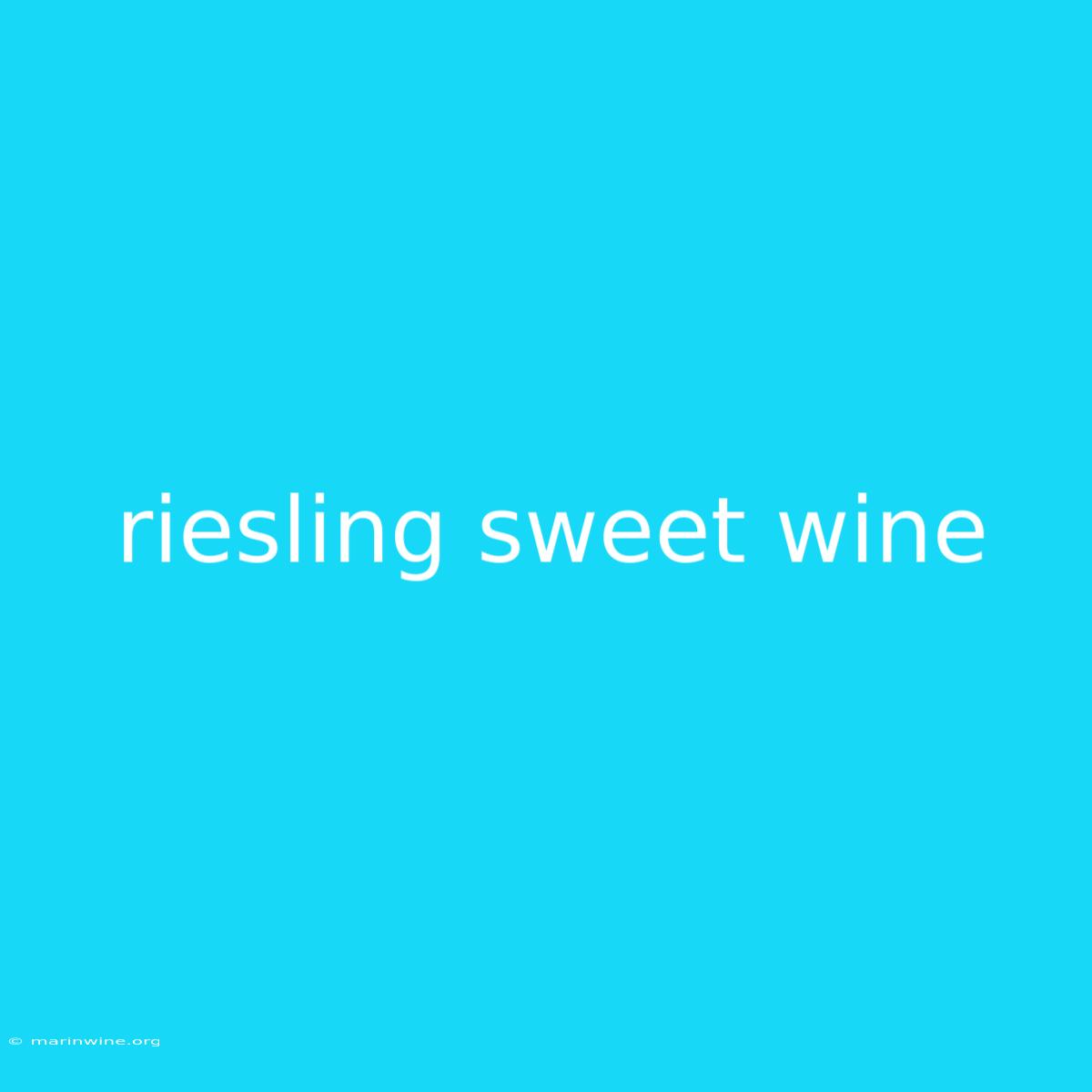The Sweet Symphony of Riesling: Uncorking the Secrets of a Delectable Wine
Have you ever wondered why Riesling is often associated with sweetness? It's a bold statement, considering the wide range of styles this grape can produce. But the truth is, Riesling is capable of creating a spectrum of wines, from bone-dry to intensely sweet.
Why this matters: Understanding the diverse nature of Riesling is crucial for appreciating its versatility. It can be the perfect companion to a light lunch, a spicy meal, or even a decadent dessert. This article delves into the world of Riesling, particularly focusing on its sweet expressions.
Key Takeaways of Riesling Sweet Wine:
| Takeaway | Description |
|---|---|
| Versatility | Riesling's sweetness can range from subtle hints to pronounced flavors. |
| Food Pairing Potential | A versatile wine that pairs well with a variety of dishes, especially spicy cuisines and desserts. |
| Aging Potential | Sweet Rieslings can age for decades, developing complex flavors and aromas. |
| Unique Character | Known for its signature notes of honey, citrus, and floral aromas. |
Riesling Sweet Wine
Introduction: Sweet Riesling is a delicate and nuanced wine that showcases the grape's inherent sweetness. This style is often characterized by its vibrant acidity, which balances the sweetness and creates a refreshing and harmonious taste.
Key Aspects:
- Residual Sugar: The defining characteristic of sweet Riesling is its residual sugar, meaning sugar remains in the wine after fermentation. This residual sugar contributes to the wine's sweetness.
- Botrytis cinerea: In some cases, sweet Riesling wines are produced using botrytis cinerea, a noble rot that concentrates sugars and flavors. This results in wines with intense sweetness, honeyed notes, and a complex character.
- Acidity: The high acidity of Riesling is crucial for balancing the sweetness. It provides a refreshing counterpoint and helps to maintain the wine's vibrancy and complexity.
Botrytis and its Impact
Introduction: Botrytis cinerea, commonly known as noble rot, plays a crucial role in the production of sweet Riesling wines. This mold thrives in humid, cool conditions and concentrates the grapes' sugars and flavors, resulting in intensely sweet and complex wines.
Facets:
- Development: Botrytis develops on the grapes' skins, causing them to shrivel and concentrate their sugars. This process can take weeks or even months.
- Flavor Profile: Botrytis-affected Rieslings develop unique flavors, including honey, apricot, and citrus, adding depth and complexity.
- Risk Mitigation: Vineyard management practices play a crucial role in controlling the development of botrytis and ensuring quality.
The Versatility of Sweet Riesling
Introduction: Sweet Riesling is a surprisingly versatile wine that pairs well with a variety of foods, from spicy Asian dishes to rich desserts.
Further Analysis:
- Spice and Sweetness: The acidity of Riesling can beautifully cut through the heat of spicy cuisines, such as Thai curry or Indian vindaloo.
- Dessert Pairing: Sweet Riesling wines are a natural match for rich desserts like fruit tarts, chocolate mousse, and panna cotta.
- Cheese and Wine: The sweetness of Riesling complements the creamy texture and salty notes of blue cheese, such as Roquefort or Gorgonzola.
Information Table: Sweet Riesling Regions
| Region | Characteristics |
|---|---|
| Mosel, Germany | Steep slopes and cool climate contribute to the production of intensely sweet Riesling wines. |
| Alsace, France | Known for its late-harvest Rieslings, often with botrytis, producing rich and complex wines. |
| New York State, USA | Home to a growing Riesling production, including sweet styles with a focus on local fruit. |
| Australia | Produces both dry and sweet Rieslings, with notable examples from the Clare Valley and Eden Valley. |
FAQ for Riesling Sweet Wine
Introduction: Here are some common questions about Riesling sweet wines:
Questions:
- Q: Is all Riesling wine sweet? A: No, Riesling can be produced in a variety of styles, from dry to sweet.
- Q: How can I tell if a Riesling is sweet? A: Look for labels that indicate "sweet," "late harvest," or "trockenbeerenauslese" (TBA).
- Q: What does a sweet Riesling taste like? A: Sweet Rieslings often have flavors of honey, apricot, citrus, and floral notes.
- Q: How long can sweet Riesling age? A: Sweet Rieslings can age for decades, developing complex flavors and aromas.
- Q: How should I serve sweet Riesling? A: Serve chilled, at about 45-50 degrees Fahrenheit (7-10 degrees Celsius).
- Q: What are some good food pairings for sweet Riesling? A: Spicy Asian cuisine, desserts, and blue cheeses.
Tips for Enjoying Riesling Sweet Wine
Introduction: Here are some tips for maximizing your enjoyment of Riesling sweet wines:
Tips:
- Choose the right style: Consider your palate preferences and the dish you will be pairing the wine with.
- Pay attention to the label: Look for terms like "sweet," "late harvest," or "TBA" to indicate sweetness level.
- Chill the wine: Serve sweet Rieslings chilled for optimal refreshment and flavor.
- Explore different regions: Discover the unique character of Rieslings from diverse regions like Germany, Alsace, and Australia.
- Pair with food: Experiment with different food pairings to uncover the versatility of sweet Riesling.
Summary of Riesling Sweet Wine
This article has explored the world of sweet Riesling, uncovering its fascinating characteristics and versatility. From the impact of botrytis to the perfect food pairings, we've highlighted why this wine deserves a prominent place in your wine repertoire. Sweet Riesling offers a captivating symphony of flavors, promising a delightful journey for your taste buds.
Closing Message: The next time you reach for a sweet wine, consider exploring the world of Riesling. With its range of sweetness, vibrant acidity, and food pairing versatility, you'll be pleasantly surprised by the delightful discoveries awaiting you. Cheers to the sweet symphony of Riesling!

